Geothermal Heat Pumps
Outstanding home comfort through advanced technology
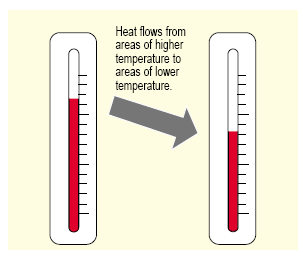 How would you like to have a heating and air conditioning system in your home that can:
How would you like to have a heating and air conditioning system in your home that can:- Save energy and slash electric bills
- Cut greenhouse gas emissions
- Rid your yard of unsightly outdoor equipment
- Drastically reduce the cost of your hot water
- Reduce maintenance costs
What They Do
Geoexchange systems provide heat in the winter and cooling in the summer, at efficiencies that are far better than those for most alternative systems. Like conventional heat pumps, they are essentially air conditioners that can also run in reverse to provide heat in the winter. The primary difference is that they rely on the nearly constant temperature of the earth for heat transfer instead of the widely fluctuating temperatures of the outside air. That is the key to the geoexchange unit's surprising efficiency.
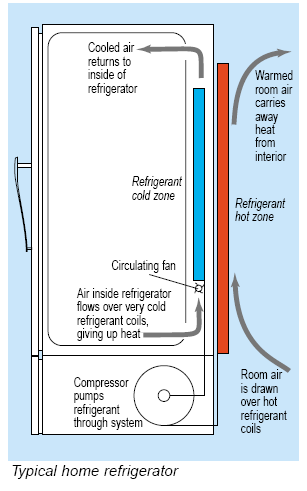
How They Work
Geoexchange systems, like common heat pumps and air conditioners, make use of a refrigerant to help transfer (or pump) heat into and out of your home. The refrigerant helps the geoexchange system take advantage of two primary principles of heat transfer:
- Heat energy always flows from areas of higher temperature to areas of lower temperature.
- The greater the difference in temperature between two adjacent areas, the higher the rate of heat transfer between them.
The Super Efficiency of Geoexchange
Standard heat pumps, while relatively simple to operate, face one major challenge. Their operating efficiency is lowest when demand is highest; that is, heat pumps have to work hardest when we want the most from them. As we've just seen, a regular heat pump extracts heat energy from outside air in winter, and rejects heat to outside air in summer. Unfortunately, the colder the outside air, the more difficult it is to extract heat from it, and the hotter the outside air, the harder it is to transfer heat to it. The temperature difference between the air and the refrigerant is small in both cases, lowering heat transfer rates within the system. Yet, the colder it gets outside, the higher the rate of heat loss through windows, around doors, and through walls and roofs, and the more heat we need to pump inside to keep indoor temperatures comfortable. In summer, we face a similar dilemma. The hotter it gets outside, the higher the rate of heat infiltration into the house, and the more heat removal we need to maintain comfort. A geoexchange system eliminates this dilemma by using the relatively constant temperature of the earth as a heat source in winter and a heat sink in summer, instead of outside air. Throughout most of the U.S., the temperature of the ground below the frost line (about 3 to 5 feet below the surface) remains at a nearly constant temperature, generally in the 45°—50°F range in northern lattitudes, and in the 50°—70°F range in the south. So, in the winter, a geoexchange unit can extract heat from ground that's relatively warm compared to the cold outside air, and in the summer, it can discharge heat to ground that is relatively cool, compared to the hot outside air. Since the difference between the refrigerant temperature and the ground temperature remains relatively high in both seasons, so do heat transfer rates. Consequently, the geoexchange system operates at much higher year-round efficiencies than a standard heat pump.
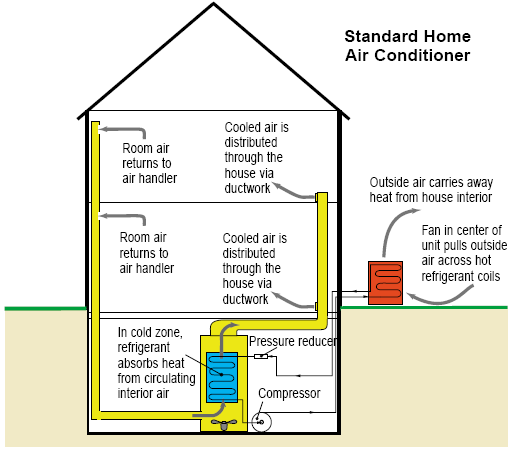
The Cleanliness of Geoexchange Systems
Installing a geoexchange system is environmentally responsible. Since a geoexchange system merely transfers heat from the ground into your home in winter, you don't need to burn any fossil fuels to create a warm interior environment. This approach drastically reduces carbon dioxide emissions (a greenhouse gas) compared with the operation of other heating systems, and completely eliminates the heating system as a potential source of carbon monoxide fumes within your home— making the geoexchange system an environmentally friendly as well as safe and healthy alternative to traditional oil and gas furnaces.
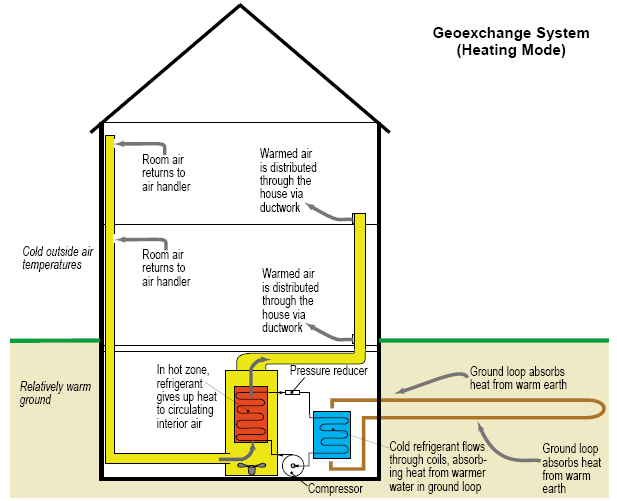
Making The Ground Connection
The unique aspect of the geoexchange system, and the key to its lengthy list of benefits, is the ground loop. The ground loop provides the means of transferring heat to the earth in summer, and extracting heat from the earth in winter. Physically, the "ground loop" consists of several lengths of plastic pipe typically installed either in horizontal trenches or vertical holes that are sub-sequently covered with earth and landscaping of your choice. Water inside the ground loop piping is pumped through a heat exchanger in the geoexchange unit. In the summer, it absorbs heat from the refrigerant hot zone and carries it to the ground through the ground loop piping. In winter, it absorbs heat from the earth through the ground loop, and then transfers that heat to the refrigerant cold zone. The length of the ground loop will be determined by the heating and cooling loads, which are determined in turn by the size of your home, its design and construction, its orientation, and the climate where you live. Whether the ground loop is most efficiently installed in horizontal trenches or in vertical bore holes depends on the type of soil near the surface (rocky, sandy, clay-laden, etc.), the geology of the deeper terrain in your area, and the amount of land available. Generally, horizontal loops are less expensive to install, but require more land area. Vertical holes require much less land area, but require the expense of drilling. Another ground connection scheme—called an open loop system—involves using wells instead of closed loop piping. Where water is plentiful, it can be pumped out of a well, through the heat exchanger at the geoexchange unit, and then pumped back into another well to return to the groundwater. Since the water merely absorbs or gives up heat, but is not altered in any other way, it leaves the geoexchange unit as pure as it was when it entered it. Any one of these installation schemes results in the same high efficiency, when properly sized. Moreover, once the ground loop is installed, you can typically forget about it. The polyethylene piping (the same type used for cross-country natural gas lines) does not degrade, corrode, or break down in ground or water contact, so sound installations are expected to last 50 years or more.
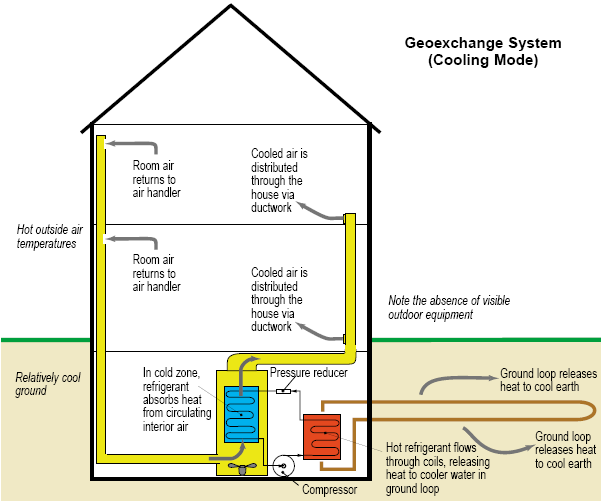
Free Hot Water
As a side benefit, most geoexchange systems can be designed to produce free hot water during the summer, by using waste heat extracted from the interior air during the air conditioning season. Even in the winter, the geoexchange unit can often help to reduce the use of electricity or gas by the hot water heater.
Premium Comfort Year Round
One of the complaints often heard from the owners of standard heat pumps is that the air coming from the vents in the winter is cool, creating a sense of draftiness. While the air is actually warmer than room temperature by several degrees, it is much cooler than the average person's skin temperature. Heat transfer principle #1 says that heat will flow from our skin (an area of warmer temperature) to the air coming from the vents (an area of cooler temperature). And that makes the air feel cold and "drafty." Geoexchange systems don't have this problem. Because the ground temperature is much warmer than typical winter air temperatures, the geoexchange system can make the air much warmer than our skin—typically well over 100°F. Since the air from the vents is at a higher temperature than our skin, heat flows from the air to our skin, making us feel warm and cozy. Geoexchange systems also provide superior year-round humidity control, and modular designs often make zoned heating and air conditioning practical— for even more comfort control through the entire house.
 More information about geoexchange is available from the Geothermal Heat Pump Consortium, a nonprofit organization that promotes the use of geoexchange technology. GHPC acts as a resource for anyone wishing
to know more about geoexchange and can provide technical expertise, marketing research data and insight, and current industry activity status. GHPC can be reached toll-free at 1-888-333-4472, or on the Internet at www.geoexchange.org.
More information about geoexchange is available from the Geothermal Heat Pump Consortium, a nonprofit organization that promotes the use of geoexchange technology. GHPC acts as a resource for anyone wishing
to know more about geoexchange and can provide technical expertise, marketing research data and insight, and current industry activity status. GHPC can be reached toll-free at 1-888-333-4472, or on the Internet at www.geoexchange.org.